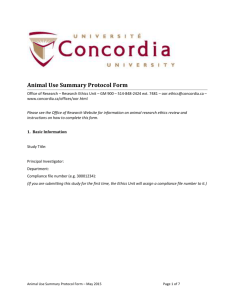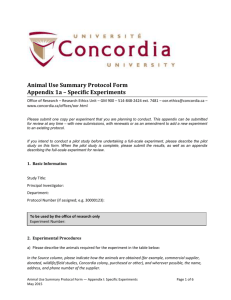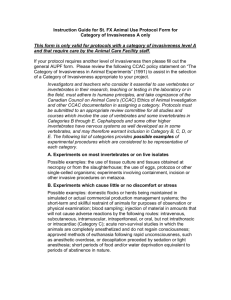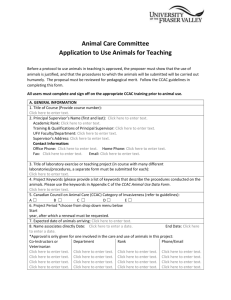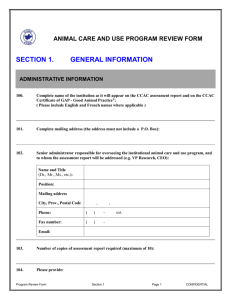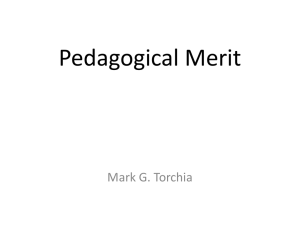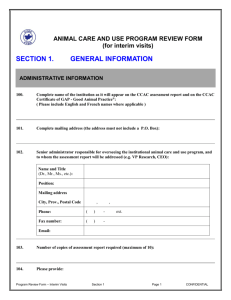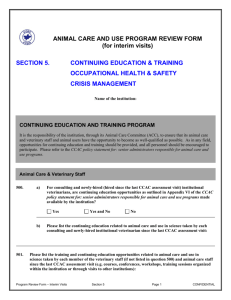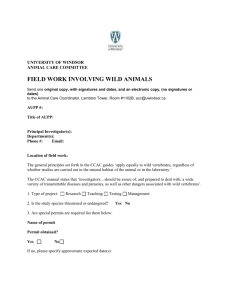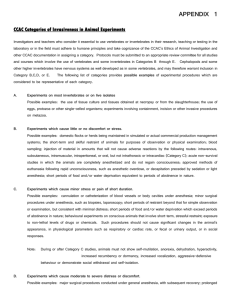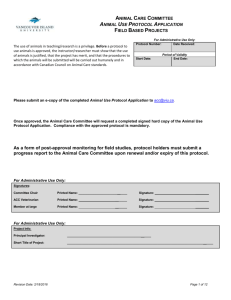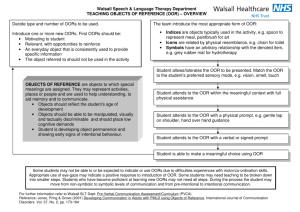Office of Research - Concordia University
advertisement
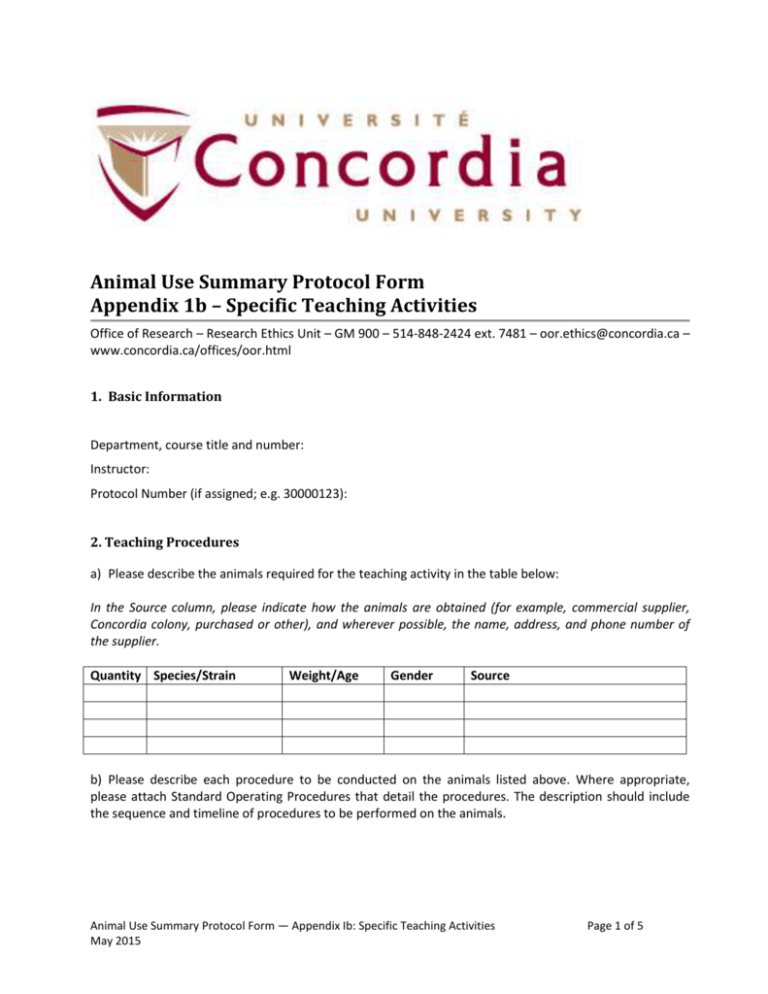
Animal Use Summary Protocol Form Appendix 1b – Specific Teaching Activities Office of Research – Research Ethics Unit – GM 900 – 514-848-2424 ext. 7481 – oor.ethics@concordia.ca – www.concordia.ca/offices/oor.html 1. Basic Information Department, course title and number: Instructor: Protocol Number (if assigned; e.g. 30000123): 2. Teaching Procedures a) Please describe the animals required for the teaching activity in the table below: In the Source column, please indicate how the animals are obtained (for example, commercial supplier, Concordia colony, purchased or other), and wherever possible, the name, address, and phone number of the supplier. Quantity Species/Strain Weight/Age Gender Source b) Please describe each procedure to be conducted on the animals listed above. Where appropriate, please attach Standard Operating Procedures that detail the procedures. The description should include the sequence and timeline of procedures to be performed on the animals. Animal Use Summary Protocol Form — Appendix Ib: Specific Teaching Activities May 2015 Page 1 of 5 c) What is the highest category of invasiveness to which animals could be exposed as part of this experiment? Please refer to the CCAC website (http://www.ccac.ca/en_/standards/policies/policycategories_of_invasiveness) for complete descriptions and examples of each category of invasiveness. ☐ A: Experiments on most invertebrates or on live isolates ☐ B: Little or no discomfort or stress ☐ C: Minor stress or pain of short duration ☐ D: Moderate to severe distress or discomfort ☐ E: Severe pain near, at, or above the pain tolerance threshold of unanesthetized conscious animals d) Please choose the applicable classification(s): ☐ Acute: Utilizing an animal for a brief period (less than 24 hours), followed by euthanasia or return of the animal to source, or humanely euthanizing an animal upon receipt or after a brief housing period during which time no manipulations other than standard management procedures are performed, i.e. anesthetized without recovery, euthanized for tissue collection, etc. ☐ Chronic: Maintaining the animal and performing experimental procedures during this time, i.e. feeding trials, antibody production, breeding colony, recovery surgery. 3. Animal Numbers and Refinement a) For the animals undergoing the procedures described in section 2b), please explain the design of the teaching activity, explaining how the total number of animals to be used was determined. Please specify the ratio of students to animals. b) Are any additional animals required, for example, to compensate for unsuccessful procedures? If so, how many? c) How has the number of animals proposed for this teaching activity been minimized while achieving the intended pedagogical result? Please describe any measures used to reduce the use of animals, by minimizing number of animals and/or maximizing the pedagogical value of the teaching activity, as well as any statistical considerations. Please specify the ratio of students to instructors in the course. Animal Use Summary Protocol Form — Appendix Ib: Specific Teaching Activities May 2015 Page 2 of 5 d) What refinements have been made to minimize pain, distress, or discomfort to the animals? 4. Animal Care a) Where will the animals be housed before, during, and after the teaching activity? Please provide the building and room number. Where will the teaching activities take place? Please provide the building number and room. Please note that university veterinarians and ACF personnel have care and oversight of all animals regardless of where they are housed. b) How often will the animals be observed or monitored to assess their condition before, during, or after the teaching activity? Please attach any assessment sheets to be used to document observations or monitoring. c) Please describe any housing or environmental enrichment arrangements for the animals. 5. Humane Endpoints Please note that this question refers to endpoints arising due to stress or complications related to the teaching activity. Please refer to section 9 of the Animal Use Summary Protocol Form (AUSPF) for euthanasia at the end of a teaching activity. a) What clinical conditions or abnormalities could arise, or are expected to arise, as a result of the proposed teaching activity? b) If one of the conditions or abnormalities described in 5a) arise, what endpoints should be used to determine when to intervene to alleviate pain or distress? For mammals, this might include, for example, increased grooming, vocalization or postural changes, or physical changes such as anorexia, dehydration or diarrhea. For fish, postural or equilibrium issues, anorexia, gasping, clamped fins, fin rot, Ich and glancing could be examples of endpoints. Animal Use Summary Protocol Form — Appendix Ib: Specific Teaching Activities May 2015 Page 3 of 5 c) What intervention is appropriate, if the animal reaches the endpoints described in section 5b), for example, euthanasia, treatment, or terminating a particular procedure? If CO2 euthanasia will be used, please provide a justification, and methodology that satisfies the conditions set out in the CCAC guidance1. Please specify any analgesics and anesthetics that will be used, as well as the dosages and routes of administration, procedures used to verify that and any other special procedures. 6. Emergency Care If emergency veterinary care becomes necessary, what information, specific instructions, indications, or contra-indications should the veterinarian or manager of the ACF be aware of? Please note that reasonable attempts will be made to contact and consult the personnel listed on your AUSPF. However, the final decision regarding emergency care is at the professional discretion of the veterinarian or the manager of the ACF. ☐ Standard veterinary care is appropriate ☐ Other (please specify): 7. Declaration and Signature I declare that this Appendix to the AUSPF accurately describes the proposed animal use. I will only use animals in accordance with an Animal Use Summary Protocol Form and its appendices approved by the University Animal Research Ethics Committee (UAREC). I will not deviate from this protocol unless the modification has been approved by the UAREC. I will ensure that only the personnel listed in section 2, and students registered for the course referenced in section 1, conduct procedures involving animals under this Animal Use Summary Protocol Form. I will ensure the personnel and students have all required training and that they are competent in executing the approved procedures. If any unexpected problems or complications involving animal health and well-being occur during this study, I will complete an Animal Incident Report and deliver it to the Manager of the Animal Care Facility within 24 hours of the incident. 1 http://www.ccac.ca/Documents/Standards/Guidelines/Euthanasia.pdf Animal Use Summary Protocol Form — Appendix Ib: Specific Teaching Activities May 2015 Page 4 of 5 I acknowledge that approval will expire on the date specified on the Certificate of Ethical Acceptability for Research or Teaching Involving the Use of Animals. I will not use animals after that date unless I have duly applied for renewal of my approval. I will ensure that all animals used in this protocol will be cared for in accordance with: The CCAC Guide to the Care and Use of Experimental Animals and any other applicable CCAC policy; The Concordia University Policy on the Ethical Use of Animals in Research and Teaching and its associated procedures. This form may be submitted by e-mail in MS Word or PDF format to oor.ethics@concordia.ca. E-mail submissions sent from the instructor’s official Concordia address will be deemed equivalent to an ink-onpaper signature. Signature of Instructor: ________________________________________ Date: ____________________________ Animal Use Summary Protocol Form — Appendix Ib: Specific Teaching Activities May 2015 Page 5 of 5
